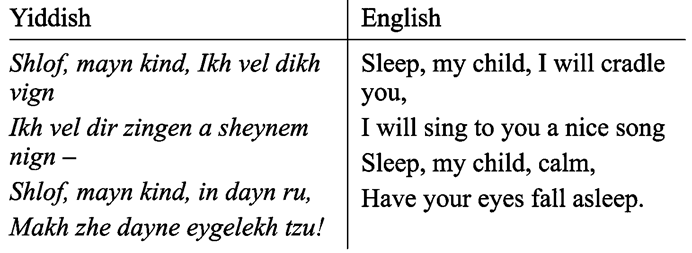
Probably the source for Stutschewsky’s arrangement, as in the case of Unter dem Kinds Wiegele, was Alexander Schitomirsky’s post-romantic lied arrangement of this Yiddish song for voice, viola and piano (Schitomirsky 1912).[1] The melody marked con sordino (muted violin or cello) is almost identical to that of Schitomirsky. Both arrangements are in F# natural minor with a lowered second degree at the penultimate bar. The tunes also share similar slurs and ornaments, fermata ending, and a slow metronome appropriate for a lullaby (quarter = 46 in Schitomirsky and quarter equal 58-63 in Stutschewsky’s.)
However, Stutschewsky’s personal interpretation is again expressed in his piano part. The piano does not double the melody, but provides a rocking cradle-sway feel through a persistent rhythmic pattern: ascending fifth or octave eighth notes in the left hand, answered by a leaning quarter-note chord in the right hand. Chords remote from the main tonality – i.e. B# diminished seven in bar 3, G major in bar 4, D# diminished seven in bar 7, and augmented E chord in bar 8 – surprises the listener. These harmonic deviations add a reflective, biting note to this cradlesong. With this tune, Stutschewsky ties up the first sub-section of his work. This subsection depicts a day’s cycle from the Jewish experience. It opens with an intimate night-time moment of mother and child, followed by Hassidim and their rebbe walking to an event or dancing in a tish, the morning rising and laborers going to work in the Promised Land, and back to night-time with an ambivalent song in either Yiddish or Hebrew, that greys out the diaspora/Israel borderline.
______________________________
[1] The chamber arrangement is a post-romantic lied and the viola is marked con sordino throughout the piece, as in Stutschewsky’s arrangement. Schitomirsky publisher another arrangement of the same song for soprano and two alto voices with harmonium (Kisselgoff, Schitomirsky and Lwow 1912, No. 39).





